Bodyweight training is a versatile and accessible fitness method using your own weight as resistance. It’s ideal for building strength, flexibility, and endurance without equipment. Downloadable PDF guides offer structured workout plans, exercise lists, and progress tracking, making it easy to start your fitness journey anytime, anywhere.
What is Bodyweight Training?
Bodyweight training is a form of exercise that uses an individual’s own weight as resistance. It involves performing movements that challenge various muscle groups without requiring external equipment. Examples include push-ups, squats, lunges, and planks. This method is highly adaptable, allowing individuals to modify exercises to suit their fitness level, whether beginner or advanced. Bodyweight training is ideal for those who prefer minimalistic workouts, as it can be done anywhere, making it a convenient option for home or travel fitness routines. Many downloadable PDF guides provide structured workout plans, exercise descriptions, and progress tracking sheets, helping users maximize their results. It’s a cost-effective way to improve strength, endurance, and flexibility.
Benefits of Bodyweight Training
Bodyweight training offers numerous benefits, making it a popular choice for fitness enthusiasts. It is cost-effective, requiring no specialized equipment, and can be performed anywhere, making it ideal for home or travel workouts. This form of exercise improves functional strength, enhancing daily activities and overall athleticism. Bodyweight routines also promote flexibility and balance, reducing the risk of injuries. They are adaptable to all fitness levels, allowing individuals to progress gradually. Additionally, bodyweight training engages the core, improving posture and stability. Many downloadable PDF guides highlight these benefits, providing structured plans to maximize results. Overall, it’s a versatile and efficient way to build strength, endurance, and confidence without the need for a gym membership.
Why Choose Bodyweight Training?
Bodyweight training is a practical and effective choice for individuals seeking a flexible fitness routine. Its accessibility stands out, as it requires no equipment and can be done anywhere, making it perfect for home workouts or while traveling. This method is also cost-efficient, eliminating the need for gym memberships or expensive gear. Bodyweight exercises engage multiple muscle groups simultaneously, improving overall functional strength and coordination. They are also scalable, catering to both beginners and advanced trainees. Many PDF guides provide structured plans, ensuring progressive overload and varied routines to avoid plateaus. With its convenience, efficiency, and adaptability, bodyweight training is an excellent option for those aiming to build strength, improve mobility, and enhance their overall fitness journey.
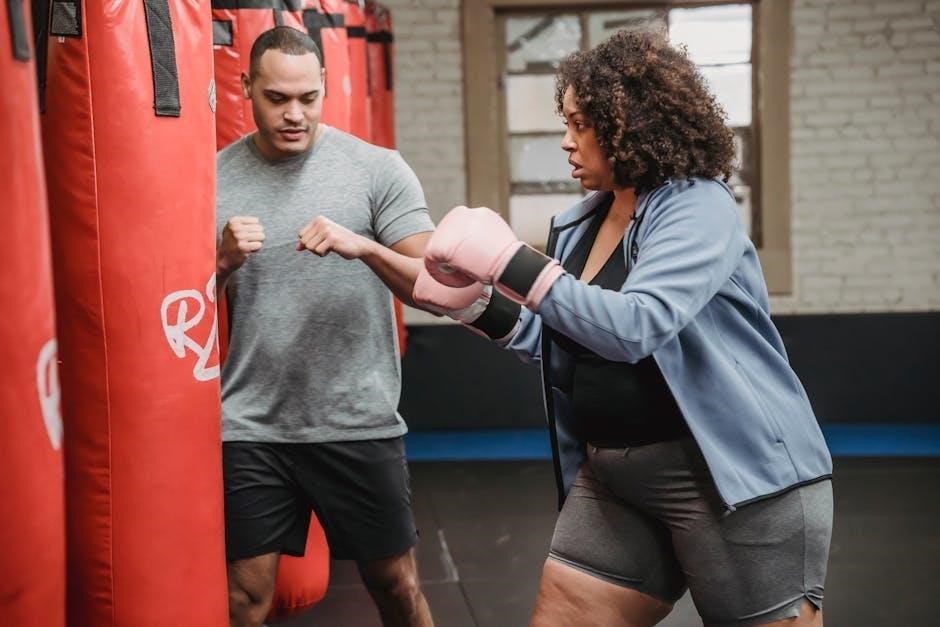
Types of Bodyweight Exercises
Bodyweight exercises include upper body workouts like push-ups and pull-ups, lower body routines such as squats and lunges, core-strengthening planks, and full-body movements like burpees. These exercises are versatile, effective, and require minimal to no equipment, making them accessible for all fitness levels. Downloadable PDF guides often categorize these exercises, providing clear instructions and progression plans to help you achieve your fitness goals efficiently.
Upper Body Workouts
Upper body workouts in bodyweight training target muscles like the chest, shoulders, triceps, and back. Push-ups are a cornerstone, with variations like diamond push-ups and plyometric push-ups for added intensity. Pull-ups and inverted rows strengthen the back and arms, while planks and pike push-ups engage the core and shoulders. These exercises are scalable, allowing progression from basic to advanced levels. For example, transitioning from knee push-ups to full push-ups or incorporating isometric holds like planches. Downloadable PDF guides often include detailed routines, ensuring balanced development and avoiding plateaus. They also provide tips on form and progression, helping you maximize results. Regular practice enhances strength, endurance, and overall upper body aesthetics effectively.
Lower Body Workouts
Lower body workouts in bodyweight training focus on strengthening the legs, glutes, and calves. Squats, lunges, and glute bridges are fundamental exercises that enhance muscle definition and functional strength. Variations like deep squats, step-ups, and side lunges challenge different muscle groups. Calf raises and heel taps target the lower legs, improving balance and endurance. These exercises are effective for building power and stability without equipment. Downloadable PDF guides often include structured routines, detailing sets, reps, and proper form to maximize results. Progression can be achieved by increasing reps or incorporating pauses. Consistency in lower body training improves overall mobility and athletic performance. It’s essential to maintain proper form to avoid injury and ensure balanced development. Regular practice yields noticeable improvements in strength and muscle tone over time.
Core Strengthening Exercises
Core strengthening exercises are essential for stability, balance, and overall athletic performance. Bodyweight training offers a variety of effective core workouts, such as planks, hollow body holds, and Superman holds. These exercises target the abdominals, obliques, and lower back muscles. Bird dogs and Russian twists are also popular for improving rotational strength and definition. Plank variations, like side planks and inverted plank walks, challenge the core from different angles. Downloadable PDF guides often include detailed routines for core-focused workouts, emphasizing proper form to prevent injury. Incorporating these exercises into your routine enhances posture, reduces back pain, and boosts overall fitness. Consistent practice strengthens the core, providing a solid foundation for other bodyweight exercises. These workouts are equipment-free and can be customized to suit all fitness levels, making them ideal for home or travel training.
Full-Body Routines
Full-body routines are comprehensive workouts that engage multiple muscle groups simultaneously, maximizing efficiency and results. These routines often combine upper body, lower body, and core exercises to create a balanced workout. Examples include circuits like push-ups, squats, lunges, and planks, which target the chest, legs, and core in a single session. Downloadable PDF guides provide structured full-body routines, such as 3 sets of 10-15 reps for each exercise, with rest periods of 30-60 seconds between sets. These routines are ideal for building overall strength, improving coordination, and enhancing cardiovascular fitness. They can be customized to suit different fitness levels, from beginners to advanced trainees. Full-body workouts are perfect for those with limited time, as they deliver a complete training session in a short duration. Consistency with these routines ensures progressive improvements in strength and endurance over time.
Structuring a Bodyweight Workout Plan
Effective bodyweight plans include warm-ups, targeted exercises, and cool-downs. Focus on balancing upper, lower, and core workouts, with clear sets, reps, and rest periods for optimal results.
Warm-Up and Cool-Down Routines
A proper warm-up prepares your body for exercise, reducing injury risk. Start with 5-10 minutes of light cardio like jogging or jumping jacks. Dynamic stretches, such as arm circles, leg swings, and torso twists, improve flexibility and blood flow; Cool-downs aid recovery by stretching major muscle groups, holding each stretch for 20-30 seconds. Incorporate deep breathing to relax and lower heart rate. Downloadable PDF guides often include detailed warm-up and cool-down routines, ensuring a safe and effective workout. Consistency in these routines enhances performance, prevents injuries, and promotes overall well-being. Make them a priority in your bodyweight training regimen for optimal results and faster recovery.
Exercise Sets and Repetitions
Effective bodyweight training relies on structured sets and repetitions to build strength and endurance. Typically, workouts include 3-4 sets of 8-15 reps per exercise, adjusting based on fitness goals. For example, push-ups and squats are often performed in higher reps to enhance endurance, while variations like single-leg squats focus on strength. Downloadable bodyweight training PDFs provide detailed rep schemes, ensuring progress. Advanced techniques like AMRAP (As Many Reps As Possible) push intensity, while timed sets add variety. Rest periods of 30-60 seconds between sets allow recovery. Consistency in following these guidelines maximizes results, helping users achieve their fitness objectives efficiently. Proper tracking through printable charts in PDF guides helps monitor progress and maintain motivation. This structured approach ensures workouts remain challenging and effective over time;
Rest and Recovery Strategies
Proper rest and recovery are crucial for maximizing the benefits of bodyweight training. Allowing muscles to recover between workouts prevents overtraining and injury. Typically, 30-60 seconds of rest between sets and 1-2 minutes between exercises are recommended. Active recovery, such as light stretching or yoga, can enhance flexibility and reduce muscle soreness. Downloadable bodyweight training PDFs often include recovery tips, emphasizing the importance of sleep and hydration for optimal performance. Adequate sleep aids muscle repair, while hydration supports overall physical function. Listening to your body and adjusting rest periods ensures sustainable progress. Incorporating these strategies into your routine promotes long-term fitness goals and maintains overall well-being. Proper recovery is as essential as the workouts themselves for achieving strength and endurance.
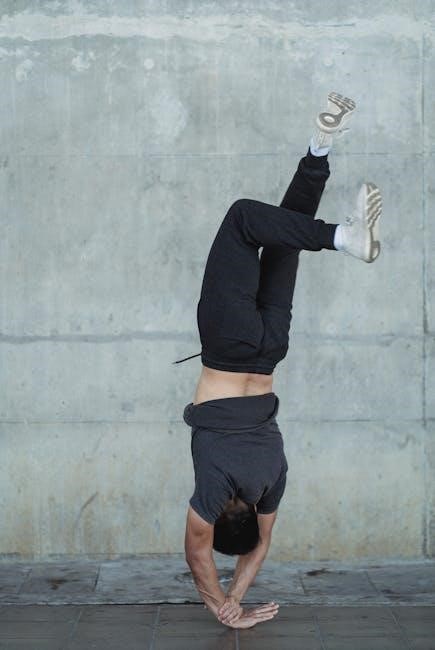
Progressive Overload in Bodyweight Training
Progressive overload involves gradually increasing exercise difficulty to build strength and muscle. This can be achieved by modifying movement angles, adding reps, or reducing rest. Downloadable PDF guides provide structured plans to implement these strategies effectively, ensuring continuous progress in your workouts.
Increasing Difficulty Over Time
Increasing difficulty over time is essential for continuous progress in bodyweight training. As you build strength and endurance, modify exercises to challenge your muscles further. For example, progress from basic push-ups to plyometric or diamond push-ups. Similarly, evolve squats into single-leg variations or pistol squats. Downloadable PDF guides often include exercise progressions, helping you gradually increase intensity. By adjusting reps, sets, or rest periods, you can ensure consistent improvement. Incorporating advanced techniques like pauses, slow tempos, or deficit exercises can also enhance difficulty. This systematic approach keeps workouts engaging and effective, preventing plateaus and fostering long-term growth.
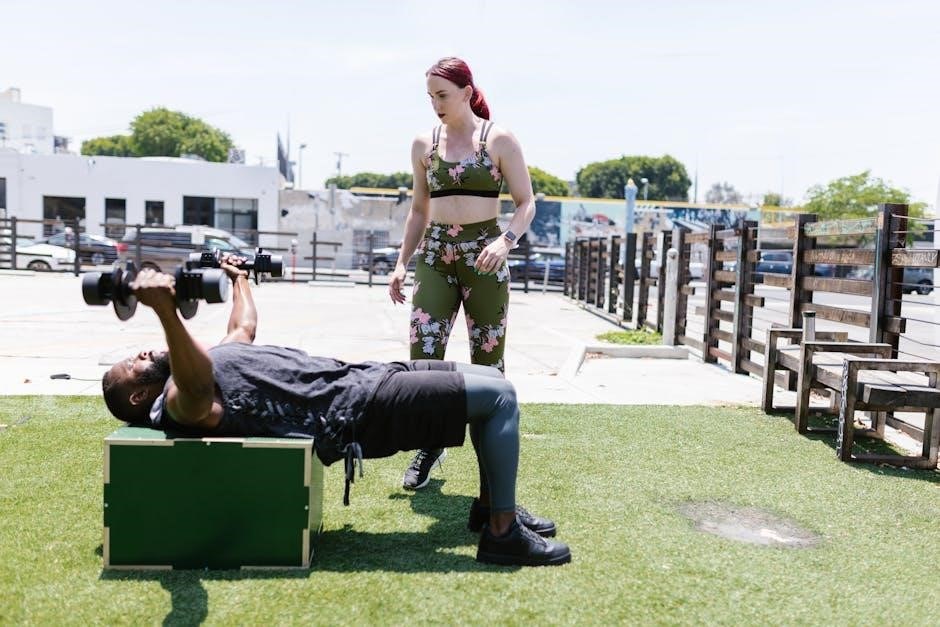
Advanced Variations of Exercises
Advanced variations of bodyweight exercises challenge even the most experienced individuals. For push-ups, try single-arm, deficit, or plyometric versions to increase intensity. Squats can evolve into pistol squats or single-leg variations for greater balance and strength demands. Pull-ups can be modified with weighted vests or assisted bands for added resistance. PDF guides often detail these variations, providing clear instructions and progressions. Plyometric movements, like burpees or jump squats, add explosive power to routines. Incorporating isometric holds, such as planche or front lever, targets stability and control. These advanced exercises ensure continuous growth and prevent plateaus, making bodyweight training a lifelong journey of mastery and progression.
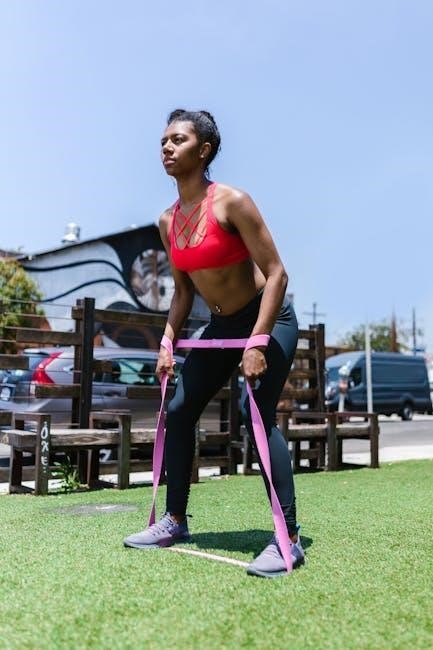
Periodization in Bodyweight Training
Periodization in bodyweight training involves structuring workouts into weekly and monthly cycles to optimize progress and recovery. PDF plans often outline seasonal phases, focusing on strength, endurance, or hypertrophy, ensuring balanced development over time.
Weekly and Monthly Workout Cycles
Weekly and monthly workout cycles are essential for effective bodyweight training. A structured approach ensures progressive overload and avoids plateaus. Many downloadable PDF guides suggest dividing routines into phases, such as strength-focused weeks followed by endurance-building months. For instance, a 4-week cycle might include two weeks of intense strength training and two weeks of active recovery. Monthly plans often incorporate variations of exercises to target different muscle groups, ensuring balanced development. These cycles are designed to maximize results while allowing adequate rest and recovery, making them adaptable for both beginners and advanced trainees. Consistency and proper planning are key to achieving long-term fitness goals with bodyweight exercises.
Phases of Training (Strength, Endurance, etc.)
Bodyweight training can be structured into distinct phases to target specific goals, such as strength, endurance, or mobility. A strength phase focuses on low-repetition, high-intensity exercises like weighted push-ups or single-leg squats. Endurance phases emphasize higher repetitions and circuit-style workouts to improve cardiovascular fitness. Mobility phases incorporate dynamic stretches and flows to enhance flexibility and coordination. Many downloadable bodyweight training PDFs provide detailed 12-week or 16-week programs that cycle through these phases, ensuring balanced development. Periodization allows for progressive overload, preventing plateaus and optimizing results. By alternating between phases, trainees can build overall fitness while addressing specific weaknesses or objectives. This structured approach makes bodyweight training adaptable for diverse fitness levels and goals. Proper planning and consistency are key to success in each phase.

Nutrition and Recovery for Bodyweight Training
Proper nutrition and recovery are crucial for bodyweight training success. Focus on balanced diets, adequate hydration, and sufficient sleep to support muscle growth and repair. Supplements can enhance results.
Diet and Muscle Growth
A well-structured diet is essential for muscle growth during bodyweight training. Focus on consuming sufficient protein to repair and build muscle tissue, with sources like lean meats, fish, eggs, and plant-based options. Carbohydrates provide energy for workouts, while healthy fats support hormone production. A calorie surplus is necessary to gain muscle, achieved through nutrient-dense foods like whole grains, fruits, and nuts. Stay hydrated to optimize performance and recovery. Adequate sleep is also critical, as muscle repair occurs during rest. Avoid processed foods and excessive sugar to maintain overall health. Downloadable PDF guides often include meal plans and nutrition tips tailored for bodyweight training, ensuring you fuel your body effectively for muscle growth and strength gains.
Hydration and Sleep for Optimal Performance

Proper hydration and sleep are crucial for maximizing performance in bodyweight training. Aim to drink plenty of water throughout the day, with increased intake before, during, and after workouts to prevent dehydration. Even mild dehydration can impair strength and endurance. Sleep plays a vital role in muscle recovery and growth, with 7-9 hours recommended nightly. During sleep, your body repairs tissues and balances hormones essential for muscle function. Poor sleep quality can hinder progress and increase injury risk. Prioritize a consistent sleep schedule and create a restful environment to enhance recovery. Downloadable PDF guides often include hydration and sleep tips to optimize your bodyweight training routine and ensure peak performance. Stay hydrated and well-rested to achieve your fitness goals effectively.

Common Mistakes and Limitations
Common mistakes include poor form, overtraining, and neglecting progressive overload. Limitations involve difficulty in building significant muscle bulk compared to weightlifting, requiring advanced variations for progression.
Avoiding Poor Form and Injuries
Proper form is crucial in bodyweight training to prevent injuries and maximize results. Poor form, such as arching the back during push-ups or letting the knees collapse in squats, can strain joints and muscles. To avoid this, focus on controlled movements and engage the core. Warm up thoroughly before workouts and rest when form begins to fail. Exercises like push-ups and squats should be performed with attention to alignment to avoid unnecessary stress. Gradually increase difficulty to build strength safely. Listening to your body and stopping when form deteriorates is key to injury prevention; Avoid excessive repetition without proper technique, as this can lead to overuse injuries. Prioritize quality over quantity to ensure long-term progress and safety.
Limitations of Bodyweight Training for Muscle Building
While bodyweight training is effective for strength and endurance, it has limitations when focusing solely on muscle building. Building significant muscle mass requires progressive overload, which can be challenging without external weights. Certain exercises lack the resistance needed to stimulate muscle growth effectively. For example, push-ups target the chest but may not provide enough load for advanced lifters. Additionally, some movements don’t isolate specific muscle groups as effectively as weighted exercises, limiting hypertrophy. Without added resistance, reaching muscle-building thresholds can be difficult. However, creative variations and advanced techniques can help overcome these limitations to some extent. Despite these challenges, bodyweight training remains a valuable tool for overall fitness and strength development.

Myths About Bodyweight Training
Common myths claim bodyweight training isn’t effective for building strength or muscle, but this is false. It can be highly effective when done correctly and progressively.
Debunking Common Misconceptions
One common myth is that bodyweight training isn’t effective for building muscle or strength. However, this is false, as exercises like pull-ups, squats, and push-ups can build significant muscle when performed progressively. Another misconception is that bodyweight workouts lack variety, but there are countless exercises targeting every muscle group. Some believe equipment is necessary for a good workout, but bodyweight training proves otherwise. Additionally, the idea that bodyweight exercises are only for beginners is incorrect, as advanced variations like single-arm push-ups and pistol squats challenge even seasoned athletes. These myths overlook the versatility and effectiveness of bodyweight training, which can be adapted to any fitness level and goal.
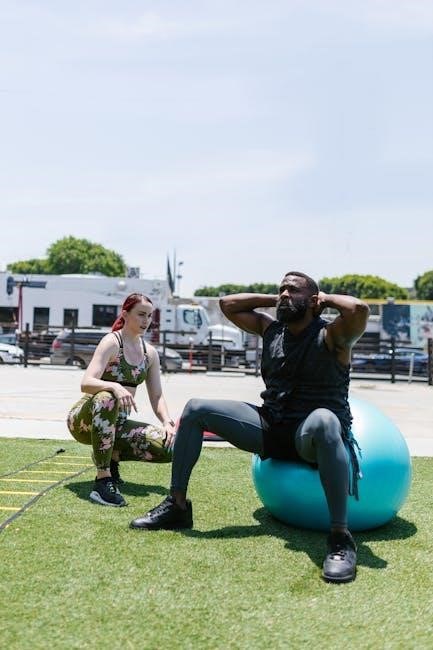
Downloadable Bodyweight Training PDFs
Free bodyweight training PDFs offer comprehensive workout plans, exercise guides, and tracking sheets. These resources provide structured routines, exercise descriptions, and progress tracking to help you stay motivated and organized.
Free Workout Plans and Guides
Downloadable bodyweight training PDFs provide detailed workout plans tailored for various fitness levels. These guides include structured routines, exercise descriptions, and nutritional advice to enhance your training. Many plans, such as 8-week or 12-week programs, focus on progressive overload and periodization to ensure consistent progress. They often feature exercises like push-ups, squats, and lunges, with variations to suit beginners or advanced trainees. Additionally, these guides include tracking sheets to monitor progress and stay motivated. Whether you’re aiming for strength, endurance, or weight loss, these free resources offer a comprehensive approach to bodyweight training, making it easy to follow and adapt to your lifestyle. They are perfect for home workouts or travel, ensuring you never miss a training session.
Printable Exercise Charts and Tracking Sheets
Printable exercise charts and tracking sheets are essential tools for monitoring progress in bodyweight training. These resources allow you to record workouts, track repetitions, and set goals. Many PDF guides include visual charts for exercises like push-ups, squats, and lunges, helping you stay organized. Tracking sheets enable you to monitor improvements over time, ensuring consistency and motivation. They often include space for noting form adjustments and nutritional advice. These tools are invaluable for planning workouts, setting realistic targets, and celebrating achievements. By using printable charts, you can maintain accountability and visualize your fitness journey, making it easier to stay committed to your bodyweight training regimen and achieve long-term success.
Real-World Applications of Bodyweight Training
Bodyweight training is perfect for home workouts and travel fitness, as it requires no equipment. It’s ideal for maintaining conditioning when away from the gym and building strength without bulky gear, making it accessible for anyone, anywhere, and promoting consistent physical improvement.
Home Workouts and Travel Fitness
Bodyweight training is an excellent solution for home workouts and travel fitness. It requires no equipment, allowing you to maintain your fitness routine anywhere. Downloadable PDF guides provide structured workout plans that can be easily followed at home or in a hotel room. These plans often include exercises like push-ups, squats, and planks, which are effective for building strength and endurance. Travel fitness is simplified with bodyweight exercises, as they eliminate the need for gym access. Additionally, these workouts are adaptable to different fitness levels, ensuring that anyone can stay active while on the go. This convenience makes bodyweight training a practical choice for consistent physical improvement, regardless of location.
Bodyweight training is a practical, effective way to build strength and stay fit anywhere. With downloadable PDF guides, you can access structured plans and track your progress, ensuring consistent improvement and a healthier lifestyle.
Final Thoughts on Bodyweight Training
Bodyweight training is a timeless and versatile fitness approach that offers numerous benefits. It enhances strength, flexibility, and endurance without requiring equipment, making it accessible to everyone. Downloadable PDF guides provide structured workout plans, exercise lists, and tracking tools, helping users stay motivated and consistent. Whether at home, traveling, or in a gym, bodyweight exercises like push-ups, squats, and planks can be adapted to suit all fitness levels. For those seeking to build muscle or improve overall health, bodyweight training is a practical and effective solution. Embrace this convenient method to achieve your fitness goals and maintain a healthy, active lifestyle anywhere.
